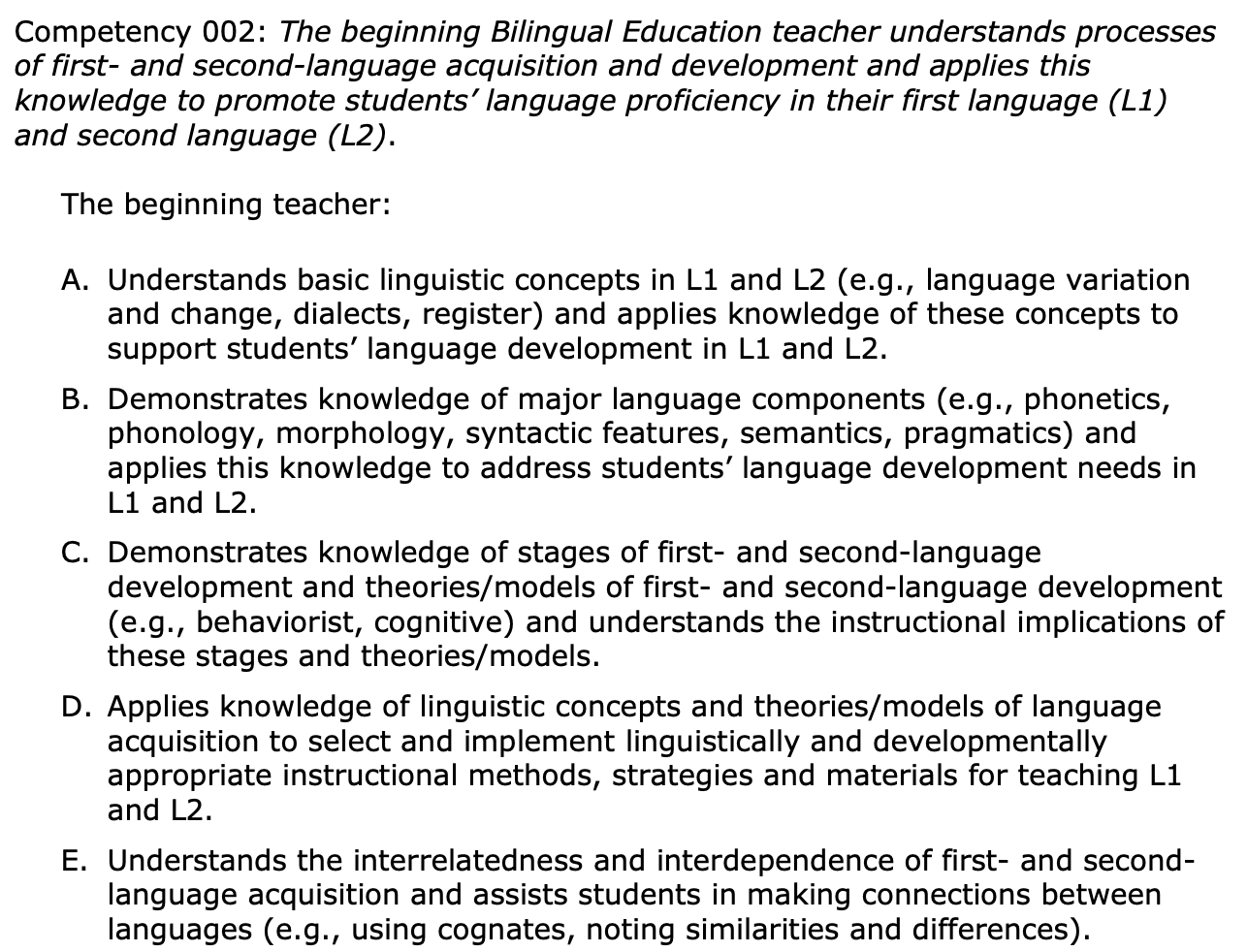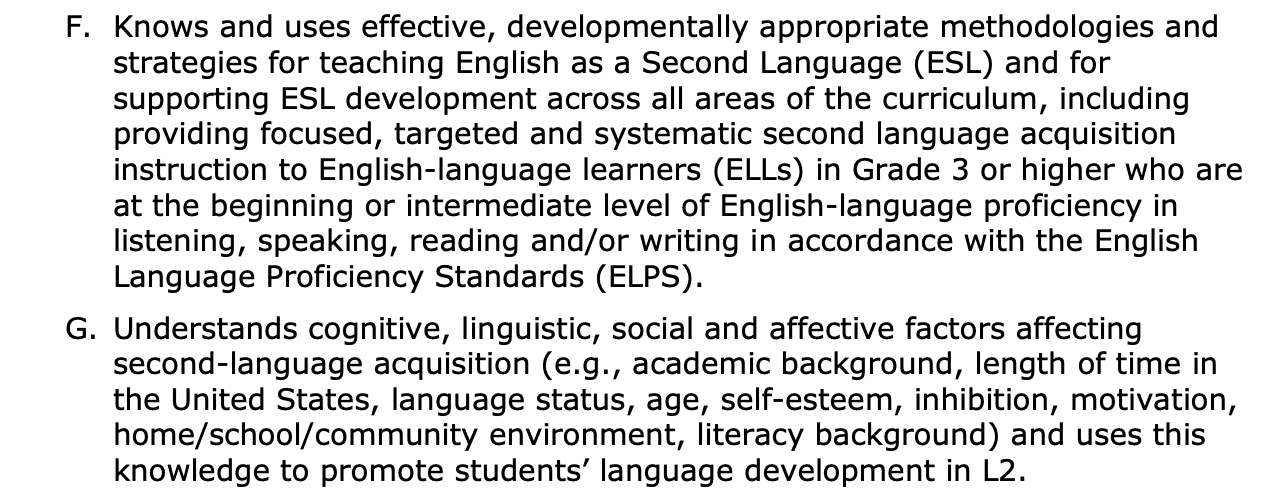TExES Bilingual Education Supplemental Competency 002
Overview


This competency is all about first- and second-language acquisition.
Here are some concepts from this competency that are likely to pop up on the test.
L1 and L2 (Interrelatedness and Interference)
Learners use L1 knowledge to learn L2. This can be helpful, referred to as interrelatedness, or harmful, referred to as interference. L1 and L2 are related in many ways, but one of the most important connections is that a better understanding and cognitive development in L1 leads to a better acquisition of L2. Receptive language skills (listening and reading) and productive language skills (writing and speaking) have similarities across all languages, so the strength of a student in L1 is a good predictor of how well that student will acquire L2.
L1 can also negatively impact how a student acquires L2 through interference. L1 interference most commonly affects pronunciation, grammar, structures, and vocabulary.
For example, there are no irregular plural nouns in Spanish, so a native Spanish-speaker might say:
“The other childs got lost” instead of, “The other children got lost.”
Another example of Spanish interference happens because in Spanish, adjectives agree with the nouns they modify. A native Spanish-speaker might say:
“Look at these beautifuls flowers!” instead of “Look at these beautiful flowers!”
Because the noun being modified is plural, a native Spanish-speaker might also make the adjective plural.
Language Acquisition Theories
There is more than one language acquisition theory. Let’s talk about two that are likely to come up on the test – behavioral and cognitive.
The Behavioral Theory was developed by B.F. Skinner and can be applied to many aspects of learning. Skinner’s behavioral theory centers around the idea that children are shaped by their environment and the reinforcement of their communication. Those who believe in this theory believe that language is developed through imitation, reinforcement of language, and copying adults. Skinner believed that language was not determined by experimentation, but by reinforcements from family members.
The Behavioral Theory focuses on how external factors shape a child’s language.
The Cognitive Development Theory (Jean Piaget) views L2 as a conscious and reasoned process that involves explicit strategies to enhance comprehension and retention of language. This theory contrasts Skinner’s theory which sees L2 acquisition as unconscious and automatic.
The Cognitive Development Theory focuses on explicit teaching and practice to shape a child’s language.
In the classroom, these theories would be applied very differently. For example, using the Behavioral Theory students would listen and speak to one another while the teacher reinforced the desired language through modeling and reinforcement. However, applying the Cognitive Theory a teacher might use vocabulary cards, scaffolding instruction, and discuss the language explicitly.
Morphology
Morphology is the study of the structure of words. To understand morphology we must first be able to define a word. A word is the smallest independent unit of language. Words are composed of morphemes, the smallest meaning-bearing units of language. Basically, a morpheme is not a word, but some words are morphemes. This distinction depends on whether the morpheme or word can stand independently. Words can stand on their own, morphemes can not.
Bound morphemes can be attached to free morphemes to form words – the best example of which are prefixes or suffixes applied to roots.
Here are some common prefixes attached to roots:
Anti- meaning against (antibiotic is an agent that works against germs)
De- meaning to separate or change (departmentalize means to divide into departments)
Dis- meaning to reverse or move away (disbelief is to not believe)
Here are some common suffixes attached to roots:
-ness (a state of being)
-ship (a position held)
-wise (in relation to)
Morphology is important to bilingual education because students’ understanding of morphology helps them acquire English faster. ELL students who understand how prefixes, suffixes, and roots are linked and build on one another spell better, understand vocabulary more fluently by using known prefixes and suffixes effectively, and have better pronunciation of known and unknown words.
Sheltered English Instructional Strategy
Sheltered English Instruction is a bilingual teaching strategy where ELLs learn content and language simultaneously; this engages ELLs above their comfort level. Teachers in sheltered English classes use direct, clear, and simple English and a variety of scaffolding to communicate input in each content area. Teachers will also make sure to connect new content to students’ prior knowledge (a technique called spiraling), but still present the material on the grade level English-speaking students are learning on. Even though teachers in a sheltered classroom are delivering content in English that could be above the ELLs’ proficiency level, they make sure to adapt as much of the lesson as possible so that ELL students are still able to understand.
SIOP, or Sheltered Instruction Observation Protocol, has been successfully used in the US for more than 15 years and it outlines the 30 most important elements of sheltered instruction that are in eight categories:
- Lesson Preparation (having a clear learning objective)
- Building Background (connecting to prior knowledge)
- Comprehensible Input (teaching just above the ELL’s comfort level)
- Strategies
- Interaction
- Practice/Application
- Lesson Delivery
- Review and Assessment
Effective Sheltered Instruction teachers use some of the following classroom strategies:
- provide many opportunities for students to interact using English
- provide ELLs with meaningful tasks and homework
- integrate listening, speaking, reading, and writing into every lesson
- provide ELLs with many opportunities to apply new knowledge
- engage students while paying attention to their pace so that all students understand each concept
